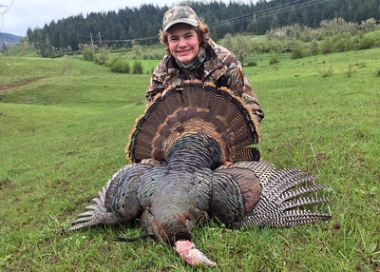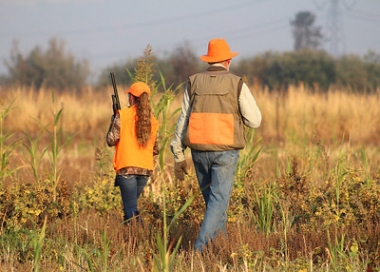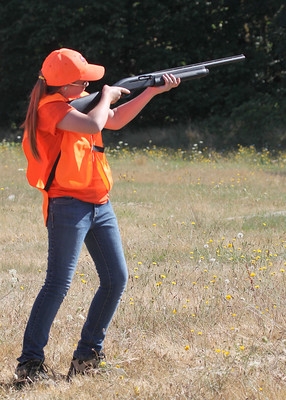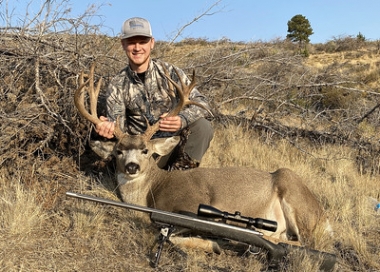
13 steps to becoming a hunter
Whether it’s spending more time outdoors or harvesting food for the freezer, there are lots reasons to become a hunter. Here’s a step-by-step approach to get from thinking about it to doing it.

1. Decide what you want to hunt for. If you’re a unsure about how the hunting thing will work for you, start SMALL. Hunting small game like rabbits and squirrels, or game birds like pheasant, chukar, quail, grouse, wild turkey and ducks are good gateways for new hunters.
If you’re all in for big game (deer and elk), consider starting with a general season deer or elk tag. “General season” means you don’t need to apply early for a tag, and the hunt area includes most public lands – and a lot of private timber lands – west of the Cascade crest*.
(A tag is an additional document you must purchase (in addition to a hunting license) in order to hunt a specific big game species.)
*Most big game hunts in eastern Oregon are “controlled” hunts, meaning hunters must apply for a limited number of tags to hunt a particular hunt area. Learn more about how controlled hunts work.
2. Take a hunter education course. Hunter education is required for youth under age 18, but we highly recommend it for new adult hunters, as well. Take a hunter education course to learn how to handle and shoot a weapon safely, and get an introduction to hunting regulations, ethics, and even some tips and techniques.
While Oregon doesn’t require adults to take hunter education, several nearby states do. So, if you see an out-of-state hunt in your future, you may need your hunter education certification.
3. Find a place to hunt. On the one hand, Oregon has over 34 million acres of public land, as well as thousands of acres of industrial forest land, open to hunters. On the other hand, it can be hard to know *exactly* where to go.
That’s why we created the Oregon Hunting Access Map (OHAM). This map highlights dozens of properties and programs that allow access for hunting: state wildlife areas, national wildlife refuges, Access and Habitat properties, Travel Management Areas and Open Fields.
The Upland Cooperative Access Program provides hunting opportunities for upland birds in the Columbia Basin.
Once you’ve decided what area to hunt, purchase a good map of that area (paper or GPS). Since not many game species are found near roads and trails, overland navigation is going to be key to your safety and success.
4. Buy/borrow some gear. For a day of hunting you’ll need a weapon and ammo, the proper clothing and boots, and an emergency kit.
- A hunting weapon – rifle, shotgun, bow – can be a big investment. However, buying a used weapon, or borrowing one from a friend that already hunts, can reduce the size of that investment.
- The right clothes and boots will keep you comfortable in the field, and that will let you hunt longer. Dress for the weather you expect to encounter, but also be prepared for sudden changes in weather. If you’re an active outdoor person, you already may have the clothes and boots you need to spend a day outside.
One thing you may not have is a hunter orange hat or vest. Wearing hunter orange makes you extremely visible in the field. And since most big game and game birds are color blind, you’ll be visible to other hunters but not necessarily your prey.
- Finally, every hunter should carry what they’ll need to deal with minor injuries, getting lost and unexpected changes in the weather.
Do I need to wear camouflage clothing?
It depends on what you’re hunting for. Ducks and turkeys have excellent eye sight and being able to blend in to the environment can be important. However, deer, elk and most other game bird species are color blind and won’t necessarily notice your bright red coat.
5. Buy a license. Everyone who is 12 years or older needs a license to hunt in Oregon. An annual youth license for kids 12-17 years is only $10, and includes fishing and shellfishing as well.
If you’re hunting for rabbits or squirrels, a basic hunting license is all you’ll need. If you’re hunting for other game, you need additional tags or validations, depending on what you’re hunting. Here’s more information about the types of and prices for tags and validations for big game and game birds.
You can buy a license online or at an ODFW license vendor. If you’re buying your license online, you can print out a hard copy on your home computer, or download your license to your smart phone using the MyODFW app.
If you prefer to buy a license in-person, you can go to one of ODFW’s license vendors. This includes many Bi-Mart and Fred Meyer stores as well as several small independent retailers.
6. Check the regulations. The Oregon Big Game and Game Bird regulations are available in print and online. To get a regulation booklet, go to an ODFW license vendor, or call your local ODFW office and they’ll send you one.
The regulations will tell you what areas are open to hunting and when, what you can harvest, and what tags and validations you’ll need to hunt different kinds of game.
7. Check the Recreation Report. The report describes hunting conditions for each of the seven hunting areas in the state. It’s updated periodically by the local ODFW wildlife biologists. Once on the Recreation Report page, select the Big Game or Game Bird hunting report and then the area you want to hunt in.
8. Practice your shooting. You don’t want to hike to the top of the John Day River Canyon looking for chukar, only to miss your shot when a bird finally flushes.
Whatever weapon you’re hunting with, commit to some serious target practice before the hunting season begins.
If you’ve never shot a gun before, we recommend a good shooting range. A good instructor will go a long way toward perfecting your shooting skills. Spending time on the range will make you a more confident shooter, and that will help more than about anything in filling your bag.
The Oregon Hunting Access Map can help you find a shooting range that’s close to you.
Many public land agencies like the FS and BLM allow shooting on their lands, and if you live in a rural area this can be a convenient place to practice. However, there are some restrictions, so be sure to check the agency websites first for the rules in your area.
9. Go hunting. You’ve selected your prey and hunting location, geared up, purchased a license, and checked the regulations. You’re ready to go hunting. ODFW has a number of online resources to help you transition from planning a hunt to actually hunting.
MyODFW.com has pointers and tips for new hunters chasing deer and elk, turkey, upland birds (pheasant, chukar, quail), ducks and rabbit.
Before you leave for your first hunt, be sure to tell someone where you’re going and when you plan to be back. Just in case something unforeseen happens.
10. Find a hunting buddy/mentor. Sometime it’s just more fun to learn to hunt with a friend or family member. And if you have a buddy that already hunts – and is willing to take you out a time or two to learn the ropes – you may be golden.
11. Take an ODFW hunting workshop. ODFW offers shotgun skills, pheasant hunting and duck hunting workshops. These hands-on events include instruction, and the chance to use ODFW guns and equipment to participate in an actual hunt. This is a great way to “try before you buy.”
Check out upcoming workshops, but also check back frequently as we’re often adding new ones.
12. Get a photo. Many people still remember years later harvesting their first pheasant or deer. Wouldn’t it be great to capture that moment with a photo? (This alone is a good reason to invite a friend or family member to go with you. Someone has to take the photo of you and your harvest.)
Be sure to send us a copy of your photo and we may use it on the ODFW website, in brochures or on signs.
13. Clean your kill. In Oregon it’s illegal to “waste” game, so if you’re successful in your hunt you’d better be ready to clean it and cook it up. The how to hunt articles referenced above, all include instructions for how to field dress and clean you game.
Want to learn more about hunting in Oregon? We’ve got all kinds of articles and tip sheets for hunting all kinds of game. Just use the search button on MyODFW.com if you’re looking for something specific. If you’d rather browse to see what’s available, go to the articles page and use the filter feature to find How to hunt articles.
Have fun and stay safe.





